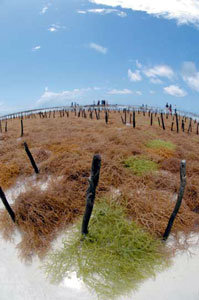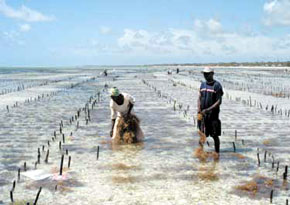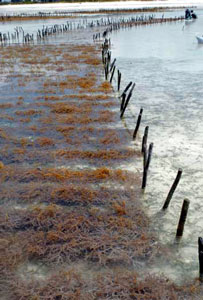| 2005 |

|
YEAR BOOK |
Martin Ryan Institute, NUI, Galway
|
Algae, Carrageenans and SeaweedAfrica
|
Seaweeds are the sole source of hydro- colloids widely used in the food industry called agars, carrageenans and alginates. The first two come from red algae and the last from brown algae (mainly kelps and wracks). Carrageenans are sulphated polysaccharides that form gels of varying strengths at low concentrations in water. Some have particularly good milk reactivity and find a wide market in the industry. The main source of dairy carrageenan was Irish Moss (Chondrus crispus) until the middle of the last century when other supplies of carageenan-producing weeds were sought. Amongst other species, the tropical and subtropical genus Eucheuma was found to be an excellent source of carrageenans known as kappa and iota carrageenan.
Initially collected from the wild from a number of tropical countries including the Philippines, Indonesia, Kenya and Tanzania, wild Eucheuma supplies rapidly became exhausted, and cultivation was initiated in the Philippines.

While some seaweeds were harvested for commercial purposes in South Africa (mainly kelps such as Ecklonia maxima and agar-producing seaweeds such as Gracilaria gracilis and Gelidium pteridifolium) and some folk use the wrack Sargassum as fish-bait, very little use was made of seaweed in the continent of Africa. Cultivation of seaweeds was a new occupation in most of the countries to which it was introduced.
In order to encourage and expand the use and cultivation of seaweeds in Africa, the EU has funded the SeaweedAfrica project (Contract number:ICA4-CT-2001-10030) through a Specific Support Action: INCO-DEV, International Cooperation with Developing Countries (5th Framework Programme, 1998-2002). The project is co-ordinated by the AlgaeBase Centre at the Martin Ryan Institute, NUI, Galway. SeaweedAfrica incorporates three European countries as partners (Ireland, Portugal and Sweden) and five African countries (South Africa, Mozambique, Namibia, Kenya and Tanzania). The project started in January 2001 and project meetings have been held in Ireland, Kenya, Portugal, Namibia and Tanzania (Zanzibar). A particular feature of the project meetings has been visits to local seaweed industry and seaweed cultivation areas.

There is currently a worldwide glut of iota-carrageenan, which mainly comes from Eucheuma denticulatum ; a higher price is paid for Kappaphycus alvarezii as it is a kappa-carrageenan producer. Unfortunately, Kappaphycus is more difficult to grow reliably as site selection is more critical, it seems, than for E. denticulatum .
Plant breeding techniques could usefully be applied to these algae to ensure that strains are tolerant of a wide range of environmental variables. There are two major obstacles to this: Kappaphycus species seemingly only rarely produces the gametes essential for producing crosses and eucheumoids are notoriously difficult to grow in the laboratory. There is considerable market resistance to direct genetic modification as GMO products have met with considerable customer resistance.


|
|
Contact: Prof. Michael D. Guiry or Dr. R�is�n Nash,
AlgaeBase Centre, Martin Ryan Institute,
National University of Ireland, Galway;
E-mail: [email protected]